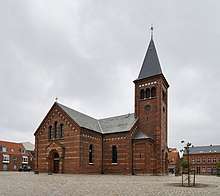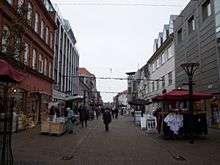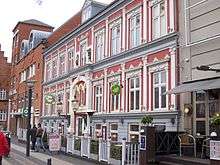Esbjerg
The city of Esbjerg is Denmark's fifth largest city and has a population of 72,613 (2003). It was established around the harbour, which the state had built in 1868 as a replacement for that harbour in Altona that had previously been Denmark's most important North Sea harbour. In 1874 Esbjerg became connected by rail to Fredericia and Varde.
Esbjerg is in Jutland, Denmark.
The town was once Denmark's biggest fishing harbour, and the harbour is still an economic driving force in the town.
Get in
The ferry route from the UK has been discontinued.
By train
The train station is in the town centre and this connects you to pretty all of Denmark and beyond. From here, DSB operates InterCity trains to Copenhagen via Kolding and Odense and Regional trains to Aarhus via Fredericia. Arriva operates trains on the smaller lines south to Ribe, Tønder and Niebüll and north to Varde, Nørre Nebel and Skjern.
By plane
- Esbjerg Airport is in the eastern part of the city, with local bus connections. There are flight connections to London (Stanstead Airport), Aberdeen and Stavanger-Bergen, Norway
- Billund Airport is western Denmark's biggest and better connected. It is conveniently located about an hour's drive from Esbjerg and there's a bus connection.
By bus
Express buses connect Esbjerg to Aalborg, Aarhus and Sønderborg as well as other towns in Denmark.
Get around
The town is centered around the harbour and shopping area (Skolegade, Kongensgade). As the town area is rather small, it is possible to get most places by walking. However, you might consider using the public bus for the more far sights as Fisheries- and Maritime Museum in Hjerting.
See

- 🌍 Man meets the sea. Sculpture depicting 4 sitting men looking over the sea.
- 🌍 Fisheries and Maritime Museum. The Fisheries and Maritime Museum is the largest institution of its kind in Denmark focusing on Danish fisheries and marine biology, the tidal wetlands (Wadden Sea), west Jutland coastal shipping and the North Sea offshore industries. So the theme of the museum can truly be said to be "people and the sea".
Do
- 🌍 Svømmestadion Danmark, Gl. Vardevej 60, 6700 Esbjerg. Visit the aquatics center Svømmestadion Danmark (on Strandby Kirkevej/Gl. Vardevej crossing)
- 🌍 Biocity Esbjerg, Gl. Vardevej 66, 6700 Esbjerg. Visit the cinema Biocity Esbjerg (right next to Svømmestadion Danmark)
- Parks of Esbjerg. Stroll around in one of the parks of Esbjerg; Byparken, Vognsbølparken, I.C. Møllerparken, Vognsbølparken, Hjerting Strandpark. In the fenced area Esbjerg Dyrehave in Vognsbølparken, you can interact directly with wildlife animals such as deer and roe
- 🌍 Island of Fanø. From Esbjerg Harbour only 10 minutes on the ferry brings you to the little island Fanø that has great beaches and the villages Nordby and Sønderho
Buy

Esbjerg City has some great options for shopping centered around the two main shopping streets. Kongensgade is a pedestrianized shopping street and has some 150 specialty shops and eateries. Torvegade, partly pedestrianized, is also worth a visit. The two converge right around the main square in town. Shopping hours are on weekdays from 9-10AM. to 5:30-6:00PM. On Saturday, most shops close down at 2PM. while Sunday nearly all shops remain closed.
In the Northern part of Esbjerg the malls 🌍 Esbjerg Storcenter. and 🌍 City Nord. offers even more shopping opportunities.
Eat
Esbjerg has some good options for eating out.
- 🌍 Mammas Pizzeria, Kongensgade 9, 6700 Esbjerg, ☎ +4588445540. located right on the pedestrian street and serves great inexpensive Italian food
- 🌍 Den Røde Okse, Tarphagevej 9, ☎ +45 75151500. located a few kilometers from the center does steak and fish well at midrange prices
- 🌍 Brasserie B, Torvegade 24 (in Hotel Brittania), ☎ +45 7513 0111. Nice open and friendly restaurant from DKK 200 for main courses.
- 🌍 Sands Restaurant, Skolegade 60, 6700 Esbjerg, ☎ +45 75 12 02 07. Sands Restaurant is very good for Danish food
Drink

Skolegade is the street where most bars and clubs are located. It is in the center of the city.
- Industrien - also serves a really good reasonably priced meal. The burgers are recommended. Occasionally live music
- Dronning Louise - Good looking place right on the town square. Has got “English pub” style live music and a good selection of beer
- Paddy Go Easy - Irish Pub
Sleep
- 🌍 Danhostel Esbjerg, Gl. Vardevej 80, 6700 Esbjerg.
- 🌍 Esbjerg Camping, Gudenåvej 20, 6710 Esbjerg V, ☎ +45 75 15 88 22. Close to the water and to the centre of Esbjerg
- 🌍 Cab Inn, Skolegade 14, 6700 Esbjerg, ☎ +45 75 18 16 00.
- 🌍 Hotel Ansgar, Skolegade 36 (at Torvet), ☎ +45 75128244, e-mail: info@hotelansgar.dk. from DKK 800.
- 🌍 Hotel Britannia, Torvegade 24 (Close to Torvet (the Square)), ☎ +45 7513 0111, e-mail: info@britannia.dk. Check-in: 2AM, check-out: 11PM. Free wireless internet from 1400 (700 weekend).
- 🌍 Hotel Scandic Olympic, Strandbygade 3, 6700 Esbjerg.
- 🌍 Hjerting Badehotel, Strandpromenaden 1, 6710 Esbjerg V. Old style beach hotel in Hjerting village approx. 10 km outside Esbjerg city
- 🌍 ECH Park - Esbjerg Conference Hotel, Stormgade 200, 6700 Esbjerg.
- Rent a holiday home.
Go next
- 🌍 Legoland, Nordmarksvej, 7190 Billund. The original Legoland is situated in the town of Billund about an hours drive from Esbjerg where Lego originates and the world heaquarters are located
- 🌍 Ribe. Denmark's oldest city with a beautiful old town
- Rømø — an island in the North Sea connected to the mainland by a causeway. Known for its sand beaches, it's a favorite among locals and visitors alike.
- Sylt — a German island likewise known for its beaches; accessible by train from the German mainland or by ferry from Rømø.
- Wadden Sea National Park — the North Sea coast has been declared a UNESCO World Heritage Site, continuing south into Germany and the Netherlands.
| Routes through Esbjerg |
| Kingston upon Hull ← (no connection) ← | W |
→ Vejen → Kolding |